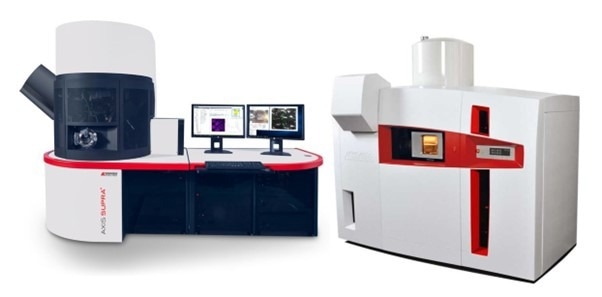XPS in academia and industry
An X-ray photoelectron spectrometer is an impressive bit of kit. The relatively low energy of the detected photoelectrons dictates that the experiments are performed in ultra-high vacuum. The spectrometer is typically constructed from bespoke stainless-steel components, with an array of pumps to create and maintain the vacuum. Combining this with the excitation sources, large photoelectron energy analyzer and associated electronic control units make an instrument that will often dominate the space in a lab.

Image credit: Kratos Analytical
However, the capabilities and applications of a modern spectrometer are truly impressive. XPS is a surface-sensitive technique, typically probing the uppermost 10 nm of the material under investigation. It’s also a quantitative technique, providing elemental and chemical detail. With XPS imaging capability this can be extended to probing the distribution of chemistry across the surface. Images can be over 10’s of millimeters or a couple of hundred microns with a spatial resolution of a few microns.
Impressive kit and useful analytical capabilities, but how is XPS used for materials characterization? This is a question that we posed to our academic and industrial Users. Dr. Mark Biesinger is the director of Surface Science Western (SSW), Canada’s leading surface analysis and materials characterization facility located at Western University in London, Ontario. He explains ‘I run our two Kratos XPS instruments for industrial and academic clients. London has strong ties to energy, automotive and other manufacturing sectors in addition to being a major medical research hub. Canada also has a very strong mineral resources sector. SSW’s work tends to focus on research and problems in these industries. We use XPS to analyze items such as adhesion failures, surface contamination problems, corrosion and material degradation issues, along with the chemistry of mineral surfaces.’

Image credit: Kratos Analytical
Dr. Stuart Leadley outlines some of the samples analyzed in Dow’s Analytical Science organization located at Dow Silicones Belgium. He comments ‘we use our XPS instrument to understand different surface-related phenomena. Examples include deposition of materials onto different surfaces, such as hair samples after treatment with shampoo and conditioner. Understanding root causes for loss of adhesion or surface contamination. Surface segregation of constituents in adhesive and paint formulations. Changes in the surface elemental composition of catalyst materials.'
The latest generation of photoelectron spectrometers is the result of decades of hardware development. Instruments such as the AXIS Supra+ are fully automated meaning that complex experiments can be designed and left running unattended. Dr Josh Lipton-Duffin works at Queensland University of Technology’s (QUT) Institute for Future Environments (IFE) highlights that ‘Our Supra gets used for a whole range of different samples – QUT has real research strengths in soft matter, biofabrication, and device technology, so we tend to see a lot of bespoke polymers, 3D printing materials, and a lot of thin films and layered compounds. The instrument runs pretty much 24 hours a day, with most users having mastered the ESCApe acquisition software well enough to know how to load and submit their samples without disturbing the previous user’s runs.’
Dr. James McGettrick, a Technology Transfer Fellow at SPECIFIC Project in the Faculty of Science & Engineering at Swansea University has similar experiences in using his instrument. ‘My boss said one thing to me when we bought the XPS in Swansea: “This has to be something that we can use for everyone in the University” and the range of samples reflects this: bone, corroding power cables, rocks, catalysts.’ He continues ‘in terms of the instrument itself, it runs 24/7 with surface spectra primarily during the week and depth profiles running most weekends. Whilst my own work focuses on photovoltaic materials – perovskite, organic photovoltaics and semi-conducting materials in particular – we’re part of a Materials Engineering department with a strong history of working with steel and studying the electrochemistry of corrosion. Corrosion can make surface analysis complex with multiple unknown species present and the surface being a mix of conductor, semiconductor, and insulator.’
The application of X-ray photoelectron spectroscopy and more generally surface analysis to characterizing advanced materials is considerable. As Users of XPS instruments have testified, it is one of the primary analytical tools found in both academic and industrial material characterization labs. The ability to provide elemental and chemical information from the outermost layers of surface atoms is fundamental in understanding and developing the use and application of all modern materials.